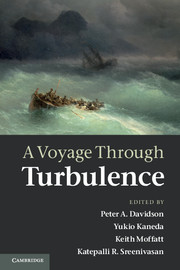Book contents
- Frontmatter
- Contents
- List of contributors
- Preface
- 1 Osborne Reynolds: a turbulent life
- 2 Prandtl and the Göttingen school
- 3 Theodore von Kármán
- 4 G.I. Taylor: the inspiration behind the Cambridge school
- 5 Lewis Fry Richardson
- 6 The Russian school
- 7 Stanley Corrsin
- 8 George Batchelor: the post-war renaissance of research in turbulence
- 9 A.A. Townsend
- 10 Robert H. Kraichnan
- 11 Satish Dhawan
- 12 Philip G. Saffman
- 13 Epilogue: a turbulence timeline
- References
3 - Theodore von Kármán
Published online by Cambridge University Press: 07 October 2011
- Frontmatter
- Contents
- List of contributors
- Preface
- 1 Osborne Reynolds: a turbulent life
- 2 Prandtl and the Göttingen school
- 3 Theodore von Kármán
- 4 G.I. Taylor: the inspiration behind the Cambridge school
- 5 Lewis Fry Richardson
- 6 The Russian school
- 7 Stanley Corrsin
- 8 George Batchelor: the post-war renaissance of research in turbulence
- 9 A.A. Townsend
- 10 Robert H. Kraichnan
- 11 Satish Dhawan
- 12 Philip G. Saffman
- 13 Epilogue: a turbulence timeline
- References
Summary
Introduction
Theodore von Kármán, distinguished scientist and engineer with many interests, was born in Budapest on 11 May 1881. His father, Maurice von Kármán, a prominent educator and philosopher at the University of Budapest, had a significant influence over his early intellectual development. After graduating from the Royal Technical University of Budapest in 1902 with a degree in mechanical engineering, von Kármán published in 1906 the first of a long string of papers concerning solid mechanics problems outside the domain of linear elasticity theory, in this case on the compression and buckling of columns. In that same year, apparently at the urging of his father, von Kármán left Hungary for graduate studies at Göttingen. For his 1908 PhD, supervised by Ludwig Prandtl, he developed the concepts of reduced-modulus theory and their application to column behavior such as buckling. Later, with H.-S. Tsien and others, he developed a nonlinear theory for the buckling of curved sheets. His final work in solid mechanics was on the propagation of waves of plastic deformation published as a classified report in 1942 and in the open literature in 1950. In von Kármán's words:
It was another version of the problem I had solved for my doctor's thesis, in which I had extended Euler's classical theory of buckling to a situation beyond the elastic limit.
(von Kármán and Edson, 1967, p. 248)- Type
- Chapter
- Information
- A Voyage Through Turbulence , pp. 101 - 126Publisher: Cambridge University PressPrint publication year: 2011
References
- 5
- Cited by



